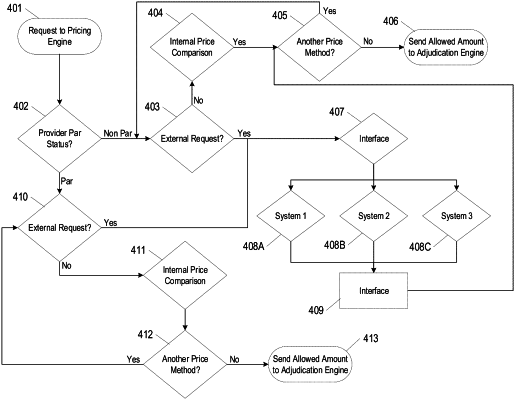| CPC G06Q 30/0283 (2013.01) [G06Q 40/08 (2013.01)] | 21 Claims |

|
1. A computer-implemented method comprising:
receiving, by one or more processors, unpriced claim data, wherein the unpriced claim data has a first format, is generated by a claim engine and comprises threshold pricing data and characteristic data for at least one claim;
selecting, by the one or more processors, a plurality of executable pricing models based at least in part on the characteristic data for the at least one claim, wherein the plurality of executable pricing models comprises one or more internally executable pricing models executable by the one or more processors and one or more externally executable pricing models executable by one or more external computing entities;
prioritizing, by the one or more processors, the plurality of executable pricing models by executing a comparison model for at least a portion of the characteristic data for the at least one claim, wherein the comparison model outputs a priority order data set defining executable routing rules for sequentially routing at least a portion of the unpriced claim data to each of the plurality of executable pricing models in series, wherein the plurality of executable pricing models comprises at least a first internally executable pricing model of the one or more internally executable pricing models and at least a first externally executable pricing model of the one or more externally executable pricing models;
sequentially routing, by one or more processors, at least a portion of the unpriced claim data to each of the plurality of executable pricing models including the first internally executable pricing model and the first externally executable pricing model, wherein sequentially routing the at least a portion of the unpriced claim data comprises:
converting at least a first portion of the unpriced claim data into a first pricing model-specific unpriced claim data set formatted for the first internally executable pricing model;
providing the first pricing model-specific unpriced claim data set as input to at least the first internally executable pricing model to initiate at least the first internally executable pricing model to generate first pricing data for the unpriced claim data;
converting at least a second portion of the unpriced claim data into a second pricing model-specific unpriced claim data set formatted for the first externally executable pricing model executable by a first external computing entity of the one or more external computing entities; and
transmitting, using an Application Programming Interface (API), the second pricing model-specific unpriced claim data set to the first external computing entity to cause the first external computing entity to initiate at least the first externally executable pricing model, and receiving, using the API, second pricing data generated by at least the first externally executable pricing model for the unpriced claim data;
consolidating, by the one or more processors and in a memory, pricing data generated from each of the selected plurality of pricing models comprising the first pricing data and the second pricing data, wherein the first pricing data and the second pricing data identify an allowed amount generated for the unpriced claim data by the first internally executable pricing model and the first externally executable pricing model, respectively;
comparing, by the one or more processors, the allowed amounts generated from each of the plurality of selected pricing models based at least in part on the unpriced claim data and the pricing data generated from each of the plurality of selected pricing models to identify a final pricing model selected from the first internally executable pricing model and the first externally executable pricing model for generating pricing data for the unpriced claim data;
accessing, by the one or more processors and from the memory, an accumulator table identifying one or more adjustments for at least a portion of the unpriced claim data; and
adjusting, by the one or more processors, final pricing data output from the final pricing model based at least in part on the unpriced claim data and the one or more adjustments to generate a final price for the unpriced claim data.
|